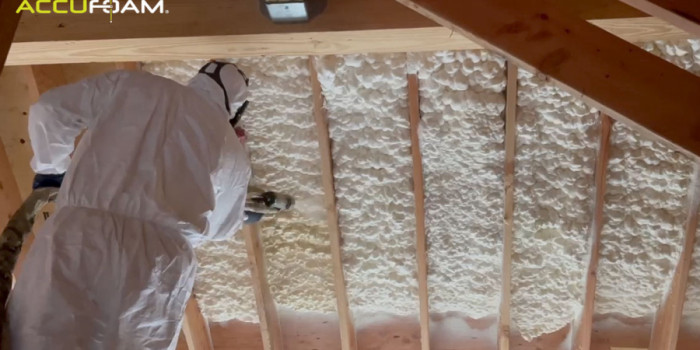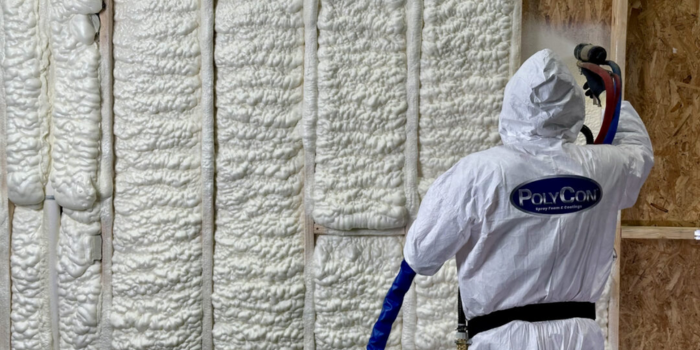Spray Foam Insulation: A Versatile Solution for Marine Applications


SPRAY FOAM MAGAZINE – Spray foam insulation has emerged as a versatile and reliable material for various industries, and the marine sector is no exception. It offers a range of benefits, including buoyancy, insulation, structural support, and moisture resistance. With its unique properties and adaptability, spray foam has proven to be an invaluable asset in shipbuilding, boat maintenance, and marine infrastructure projects. This article explores the numerous marine-related applications of spray foam and how it has revolutionized the industry.
Buoyancy, Flotation, & Moisture Resistance
One of the most significant applications of spray foam in the marine industry is the application of closed-cell spray foam to support a vessel’s buoyancy and flotation as well as to reinforce the vessel’s structural strength.
The lightweight nature and high strength-to-weight ratio of closed-cell spray foam contribute to improved buoyancy. The closed-cell foam displaces water and provides positive buoyancy. For this reason, closed-cell foam is often injected into hulls, pontoons, and other marine structures to provide buoyancy and prevent the entry of water, increasing the likelihood that a damaged vessel remains afloat.
With marine vessels, moisture infiltration is a common problem and can lead to corrosion, mold growth, and structural degradation. Spray foam’s closed-cell structure makes it resistant to water absorption, making it an effective barrier against moisture intrusion. By sealing gaps, voids, and seams with spray foam, marine engineers can help prevent water from penetrating into the vessel’s structure, thus reducing the risk of damage and prolonging maintenance intervals.
Structural Reinforcement to Applied Surfaces
Based on a 2007 Spray Polyurethane Foam Alliance performance test report, closed-cell spray foam adds up to 300% structural support to all applied surfaces.* Closed-cell spray foam has excellent adhesion properties and can bond to various substrates, including fiberglass, metal, and wood. By reinforcing hulls, decks, and bulkheads with spray foam, marine engineers can enhance structural integrity and durability, thereby prolonging the lifespan of vessels and reducing the risk of damage in rough conditions. In the event of a collision with another vessel or object, the surfaces with closed-cell foam applied are likely to incur significantly less damage than a vessel without closed-cell foam applied to its surfaces, adding another level of safety performance.
Deck and Cabin Insulation
In addition to hull insulation, spray foam is widely used for insulating decks and cabins in boats and ships. The material’s ability to expand and fill cracks and crevices makes it an excellent choice for creating a seamless, airtight seal. By insulating the deck and cabin, spray foam helps maintain a comfortable interior environment, reducing the need for heating and cooling systems and minimizing energy costs.
Reduces sound Transmission
Spray foam also acts as a sound dampener, reducing noise transmission from the engine room, generators, and other mechanical components. This feature is particularly valuable for luxury yachts and passenger ships, where creating and maintaining a quiet and peaceful environment is a top priority. The insulation properties of spray foam contribute to a more enjoyable and relaxing experience for passengers and crew members alike.

Spray foam provides additional structural integrity and helps dissipate wave energy, reducing the impact of storm surges and erosion.
Flotation and Buoyancy Devices
The closed-cell structure of spray foam provides excellent buoyancy and water resistance, making it an ideal material for marine devices, including life rafts, buoys, and floating docks.
In the event of an emergency, spray foam-filled life rafts offer a reliable and durable solution for keeping passengers and crew members safe. The foam’s high-compressive strength ensures that the life raft maintains its shape and buoyancy, even under harsh sea conditions. Similarly, spray foam-filled buoys and floating docks provide stable platforms for marine navigation, aquaculture, and recreational activities.
Corrosion Protection, maintenance, & Longevity
The marine environment is notoriously harsh on materials, with saltwater, moisture, and UV exposure contributing to corrosion and degradation. Spray foam has proven to be an effective solution for protecting metal surfaces and structures from corrosion. When applied to the interior of hull plates, bulkheads, and other metal components, spray foam creates a barrier that prevents moisture and oxygen from reaching the metal surface, thereby inhibiting the corrosion process.
Furthermore, spray foam’s adhesive properties allow it to bond strongly to metal surfaces, eliminating any gaps or voids where moisture could accumulate. This feature is particularly valuable in areas that are difficult to access or prone to corrosion, such as bilges, fuel tanks, and ballast tanks. By protecting these critical components from corrosion, spray foam helps to extend the lifespan of the vessel and reduces maintenance costs.
However, regular vessel inspection and maintenance are crucial to ensure the foam remains intact and free from damage. Periodic checks for signs of wear, tear, or water infiltration can help detect issues early and prevent costly repairs down the line.
Custom Molding and Shaping
Spray foam’s unique ability to conform to irregular shapes and contours makes it highly versatile for custom molding and shaping in marine applications. Whether filling voids in hulls, creating custom insulation barriers, or forming ergonomic seating and storage compartments, spray foam can be precisely applied to meet the specific requirements of each vessel. This versatility allows for efficient use of space and the creation of tailored solutions that maximize functionality and comfort onboard.
Environmental Considerations
When using spray foam in marine applications, it’s essential to consider environmental factors and choose closed-cell foams that are compliant with current blowing agent regulations. Many modern spray foam products are formulated to be low-VOC (volatile organic compound) and free from ozone-depleting substances, making them environmentally sustainable choices for marine construction and retrofitting projects. Any closed-cell foam product should have a Hydrofluoroolefin (HFO) blowing agent as opposed to a Hydrofluorocarbon (HFC) blowing agent. HFC blowing agents have been restricted across Canada and much of the United States. As of January 1, 2025, HFC blowing agents will be restricted everywhere in the United States.
Marine Infrastructure and Coastal Protection
Beyond its applications in boats and ships, spray foam also plays a crucial role in marine infrastructure projects and coastal protection. Spray foam is used in the construction of seawalls, breakwaters, and erosion control structures. Its ability to conform to irregular surfaces and its high compressive strength make it an ideal material for reinforcing and stabilizing these structures.
When applied to the core of a seawall or breakwater, spray foam provides additional structural integrity and helps dissipate wave energy, reducing the impact of storm surges and erosion. This application is particularly valuable in areas prone to hurricanes, tsunamis, or other severe weather events, where protecting coastal communities and infrastructure is of utmost importance.
The marine industry has embraced spray foam as a versatile and reliable material for a wide range of applications. From hull insulation and buoyancy enhancement to corrosion protection and coastal defense, spray foam has proven its worth in the demanding marine environment.
Looking Forward
As the marine industry continues to evolve and face new challenges, the use of spray foam is expected to grow. With its unique properties and adaptability, spray foam offers a sustainable and efficient solution for shipbuilders, boat owners, and coastal engineers alike. By investing in spray foam technology, the marine industry can enhance vessel performance, improve safety, and protect critical infrastructure for generations to come.
*Source: PERFORMANCE TEST REPORT (sprayfoam.org)
Spray Foam Magazine does not take editorial positions on particular issues; individual contributions to the magazine express the opinions of discrete authors unless explicitly labeled or otherwise stated. The inclusion of a particular piece in the magazine does not mean that individual staff members or editors concur with the editorial positions represented therein.
For use by SprayFoamMagazine.com & Spray Foam Magazine
Disqus website name not provided.










































